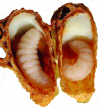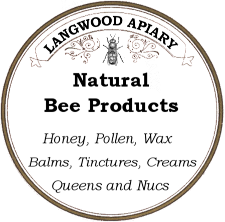
While honey, propolis, “bee bread”, wax as medicinal remedies are known since ancient times (information about their use can be found in ancient manuscripts), the “queen milk” (also known as “royal jelly”) was seriously spoken about only in the middle of the last century.
At all times, beekeepers have been looking for the answer to the question: why are working bees and queen, developed from identical eggs laid by the queen, have a different appearance, different maturation rates from egg to adult, different lifespan, different weight? The size and weight of the queen is 2 times the working bee, for the development from egg to mature the queen takes 16 days, the working bee – 21 days. The queen lives up to 6 years, the working bee in the summer – 30-35 days, and from the late autumn outgrowth – up to 80 days. Naturally, beekeepers guessed that such a difference was due to the method of feeding the larvae: the larva of the working bee received “queen milk” only for the first 3 days of life, and later it feeds on “bee bread”. The larva of the queen all days of development eats only queen milk and literally swims in it. The mature queen switches to feeding on “queen milk” only during the period of intensive egg laying. Due to this, it is able to lay up to 2 thousand eggs daily. “Queen milk” is a product of the pharyngeal and maxillary glands of the bee-nurse. The milk intended for feeding the larvae of worker bees differs somewhat in chemical composition from the milk of the mother queen cell. Therefore, it would be more correct to call “bee milk” the milk intended for the working bee larvae, and the milk for feeding the larva of the queen be called “royal milk”. For therapeutic purposes is used “queen milk”, taken from unsealed queen cells. It is also significant that the amount of “bee milk” in the cell of the working bee and the drone is 100 times less than in the mother queen cell. Since ancient times, many beekeepers have intuitively used “queen milk” as a food additive for preventive and therapeutic purposes. Officially, it was recommended as a remedy only in 1922 by Prof. R. Schauben of the Sorbonne University. By the mid-twentieth century appeared a number of in-depth studies and publications on the chemical composition of “queen milk” and its therapeutic use (Kayas, 1953, France; M. T. Gaydak, 1954, USA; S. Tudint, 1956, England; W. Pletnev, 1957, USSR; NP Yorish 1957, USSR; A Borscher, 1957, Germany; B. de Belfeber, 1958, France; IM Matushevsky and E. Kachor, 1963, Poland; P. Peychev, 1964, Bulgaria). Reports on the use of “queen milk” in medicine were heard at international conferences and symposia on beekeeping in Vienna (1956), Moscow (1969), Madrid (1974), and Bucharest (1976). The physical and chemical composition of “queen milk” is very complex. Fresh “queen milk” has a jelly-like, creamy appearance. Its color is white with a pearl shade. Taste – sour-burning, specific smell. At room temperature, the milk dries quickly and turns yellow, so it should be stored at a temperature close to zero. Under these conditions, it retains its properties for up to 3 months. Compared with other bee products, “queen milk” is the most perishable product. By chemical composition, “queen milk” is a unique combination of various components that are in ratios corresponding to the physiological needs of living organism. The main components of “queen milk”: water – 60-70%; proteins – 10-18%; carbohydrates -9-15%; fats – 1.5-7%; mineral salts – 0.7- 1.5%.
Proteins in “queen milk” are albumin and globulin in a 2:1 ratio, y-globulins make up 1/3 of all proteins. The protein composition of “queen milk” is close to the protein composition of human serum. “Queen milk” contains 22 amino acids (among which there are a number of essential – arginine, histidine, valine, methionine, tryptophan), 15 microelements, growth hormones (estradiol, testosterone, progesterone), many enzymes (amylase, catalase, invertase, protease, cholinesterase, and acidic phosphatase). Vitamin composition is represented by vitamins of group B, C, D, folic acid. Vitamin A is available in small amounts, and vitamin E is missing.
From one queen cell you can take 0.3-0.4 g of milk, and from a family designated to “queen milk” collection – 20-30 g per season.
It must be noticed that native “queen milk” contains pollen grains, pieces of wax and pieces of skin of the larva.
After removing “queen milk” from the cell it retains original biological activity up to 2 hours. Unlike other bee products, “queen milk” has the least resistance to external factors. When the rules of collecting and storing queen milk are violated, it becomes darker, its surface dries out, the protein coagulates, the antibacterial activity decreases, saturated acids disintegrate and it quickly loses its medicinal qualities, up to its complete inactivation.
Falsification of “queen milk” is unlikely, but still possible. If in doubt, it should be subjected to the laboratory test.
